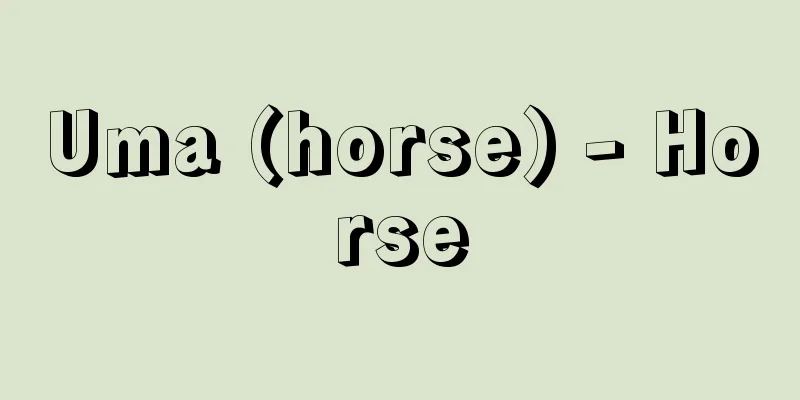Brahmin - Baramon (English spelling) Brāhmaa

|
One of the four social classes (varna) established in ancient India, the priestly class. In Sanskrit it is called Brahmana, but the Japanese pronunciation of Brahman, which is transliterated in Chinese translations of Buddhist scriptures, has become common. Brahmins are thought to have formed as a class by around 800 BC, and the religion centered on rituals such as sacrifices (yajnas) performed by them is called Brahmanism. There are four schools of Brahmins that transmit the Rig Veda, Sama Veda, Yajur Veda, and Atharva Veda, and the first three in particular shared the responsibility of performing rituals. In the 6th century BC, criticism of Brahmanism, which is all-powerful in its rituals, intensified, and new religions such as Buddhism and Jainism were born and became dominant. In particular, King Ashoka of the Maurya Empire's protection of Buddhism is famous. In response to this, Brahmins tried to expand their base by incorporating folk beliefs in gods such as Shiva and Vishnu into the old Brahmanism. In this way, various deviant beliefs based on Brahmanism gradually formed in various regions (in the 19th century, during the colonial rule, the British lumped these together and named them Hinduism). When medieval society began to take shape in the 7th and 8th centuries AD, many Brahmins, as members of village communities, began to perform community rituals and household rituals for villagers, and at the same time, various Brahmin castes were formed in various regions. Thus, Brahmins continued to have a great influence as spiritual leaders of local communities throughout the Middle Ages. However, from the end of the 19th century to the beginning of the 20th century, strong anti-Brahmin movements arose in the Maharashtra and Tamil regions, and the power of Brahmins began to decline. [Otani Hiroyuki] "Mystery and Reality: Hinduism" by Yamazaki Toshio (1969, Tankosha)" ▽ "Studies on Ancient Indian Society" by Yamazaki Genichi (1987, Tosui Shobo)" ▽ "Kingdom and Religion in Ancient India - Kings and Brahmins" by Yamazaki Genichi (1994, Tosui Shobo)" ▽ "The Code of Manu, translated by Watase Nobuyuki (Chuko Bunko)" ▽ "The Code of Manu - The Prototype of the Hindu World" by Watase Nobuyuki (Chuko Shinsho)" ▽ "The Dawn of Indian Civilization - The Vedas and Upanishads" by Tsuji Naoshiro (Iwanami Shinsho) [References] | | | | | |Source: Shogakukan Encyclopedia Nipponica About Encyclopedia Nipponica Information | Legend |
|
古代インドで成立した四つの社会階層(バルナ)の一つで、司祭階層。サンスクリット語ではブラーフマナというが、漢訳仏典における音写、婆羅門の日本語発音が一般化した。 バラモンは紀元前800年ころまでには階層として形成されていたと考えられ、彼らが執り行う供犠(きょうぎ)(ヤジュニャ)などの祭式を中心とする宗教はバラモン教とよばれる。バラモンには、『リグ・ベーダ』『サーマ・ベーダ』『ヤジュル・ベーダ』『アタルバ・ベーダ』をそれぞれに伝える四つの学派があり、とくに前三者は分担して、祭式を執行した。紀元前6世紀になると、祭式万能のバラモン教に対する批判が強まり、仏教やジャイナ教のような新しい宗教が誕生して、優勢となっていった。とくにマウリヤ朝のアショカ王による仏教保護は有名である。これに対して、バラモンは旧来のバラモン教にシバŚiva神やビシュヌVi神などの神々を信奉する民俗信仰を大幅に取り入れ、その基盤を拡大しようとした。こうして、バラモン教を基礎にしながら、各地にさまざまな偏差をもつ信仰が徐々に形成されていった(19世紀、植民地支配時代に、イギリス人はこれらをひとくくりにしてヒンドゥー教Hinduismと名づけた)。紀元後7、8世紀、中世社会が形成され始めると、多くのバラモンは村落共同体の一員として、村落の共同体祭祀(さいし)や村人の家庭祭祀を行うようになり、同時に、各地にバラモンの諸カーストが形成されていった。こうして、バラモンは中世を通して地域社会の精神的指導者として大きな影響力を保持し続けたのである。しかし、19世紀末から20世紀になると、マハラシュトラ地方やタミル地方では強い反バラモン運動が起こり、バラモンの力は衰えていった。 [小谷汪之] 『山崎利男著『神秘と現実 ヒンドゥー教』(1969・淡交社)』▽『山崎元一著『古代インド社会の研究』(1987・刀水書房)』▽『山崎元一著『古代インドの王権と宗教――王とバラモン』(1994・刀水書房)』▽『渡瀬信之訳『マヌ法典』(中公文庫)』▽『渡瀬信之著『マヌ法典――ヒンドゥー世界の原型』(中公新書)』▽『辻直四郎著『インド文明の曙――ヴェーダとウパニシャッド』(岩波新書)』 [参照項目] | | | | | |出典 小学館 日本大百科全書(ニッポニカ)日本大百科全書(ニッポニカ)について 情報 | 凡例 |
Recommend
Mirror Image Canon
…It is also called the Crab Canon. (2) and (3) ar...
Case-hardening steel
This is not the name of a specific type of steel, ...
Folding box - Oribako
〘 noun 〙 A box made by folding thinly shaved board...
Besselian year
Taking into account the effect of aberration, the ...
Kanjin Hijiri - Kanjin Hijiri
A monk who traveled around the country to solicit ...
Computer music
Music created using a computer. There are several ...
Mussel (Mytilidae) - Mussel
…A black shell found in colonies on rocky shores ...
Hable, H. (English spelling) HableH
…Official name: Republic of ChadRépublique du Tch...
Baizhang Huaihai - Hyakujo Ekai
A Chinese Zen monk in the mid-Tang dynasty. His s...
Ozokerite - The Horror
→ Earth Source: Asakura Publishing Dictionary of P...
Cheyletus eruditus
...The palps are well developed and powerful, wit...
Samurai-dokoro
It is also called "saburaidokoro." In t...
Campbell, J.
…Such hero myths developed in the areas of ancien...
Mount Kashima-Yarigatake
Located on the border between Nagano and Toyama p...
Metal cluster compounds
A general term for compounds in which metal ions a...









